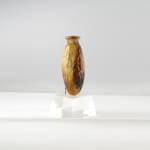Roman Glass Date-Shaped Flask, 1st Century CE - 2nd Century CE
Glass
height 7.6 cm
height 3 in
height 3 in
GF.0059
The wrinkled surface and the colour of this vessel combine to give a naturalistic representation of a dried date. Small mould-blown flasks of this type were common in the first...
The wrinkled surface and the colour of this vessel combine to give a naturalistic representation of a dried date. Small mould-blown flasks of this type were common in the first and second centuries A.D and have been found across the Roman Empire.
This vessel would have been blown into a two-part mould of two vertical sections, it is of a honey brown colour, the rim is rounded, the neck is short. The relief patterns consist of short wavy ridges imitating the wrinkles of the skin of a ripe date. Flasks of this kind would have been probably made to store perfume.(LK)
This vessel would have been blown into a two-part mould of two vertical sections, it is of a honey brown colour, the rim is rounded, the neck is short. The relief patterns consist of short wavy ridges imitating the wrinkles of the skin of a ripe date. Flasks of this kind would have been probably made to store perfume.(LK)



